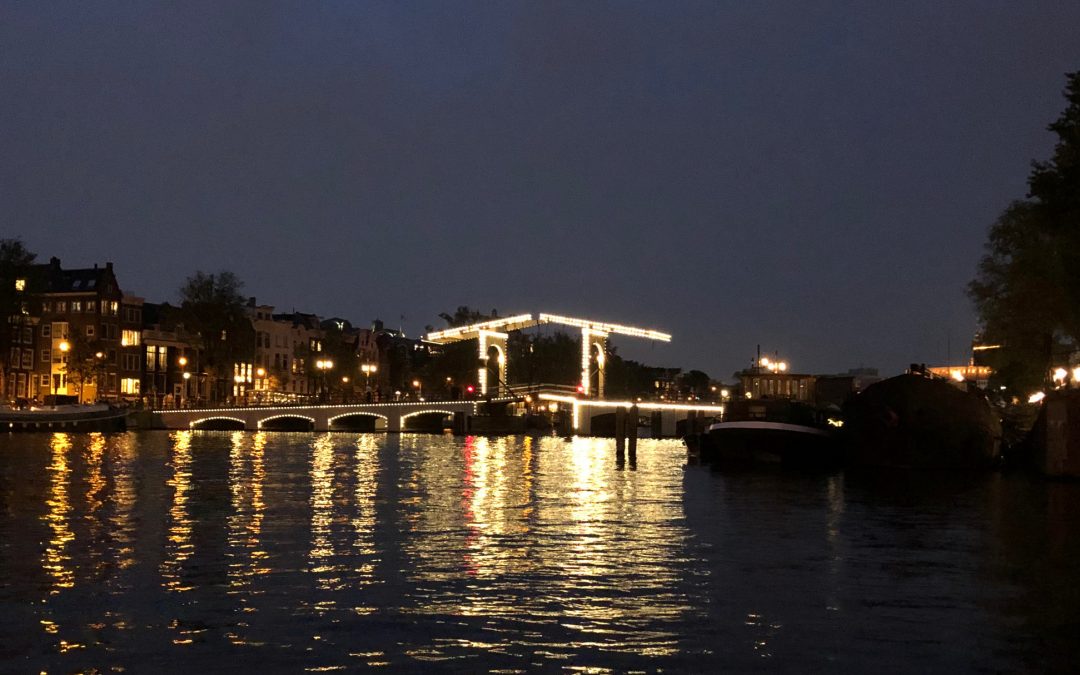Among the many charming bridges that grace Amsterdam’s iconic canals, none is more picturesque or storied than the Skinny Bridge, known in Dutch as Magere Brug. This historic wooden drawbridge, stretching elegantly across the Amstel River, has become one of the city’s most beloved symbols — drawing in tourists, photographers, couples, and architecture enthusiasts from around the globe.
In this guide, we’ll uncover the origins, myths, and practical details of the Skinny Bridge in Amsterdam, plus offer tips on how to visit and capture its magic — whether by boat, bike, or on foot.
What is the Skinny Bridge in Amsterdam?
The Skinny Bridge (Magere Brug) is a historic wooden drawbridge connecting the banks of the Amstel River at Keizersgracht and Kerkstraat in central Amsterdam. Built in the traditional Dutch double-leaf bascule style, the bridge can still be opened to allow boats to pass through.
- Name in Dutch: Magere Brug
- Location: Amstel River, near Keizersgracht
- Year Built: Originally 1691, current structure dates to 1934
- Type: White-painted wooden drawbridge (bascule bridge)
Why Is It Called the “Skinny Bridge”?
The name “Magere Brug” literally translates to “Skinny Bridge” in English. It’s believed that the bridge earned this nickname because of its narrow design, which made it difficult for two pedestrians to pass each other.
Local Legend: The Mager Sisters
A popular legend says the bridge was built by two wealthy sisters named Mager, who lived on opposite sides of the Amstel River. They wanted a way to visit one another, so they commissioned the narrow bridge. When it proved too small for practical use, the city eventually widened it.
While this story may be apocryphal, it adds to the bridge’s romantic mystique.
History of Magere Brug
The original bridge was constructed in 1691, replacing an earlier, more basic crossing. Since then, it has undergone several reconstructions and restorations:
| Year | Event |
| 1691 | First bridge built (extremely narrow) |
| 1871 | Replaced by a wider version |
| 1934 | Current version constructed in same classic style |
| 1969 | Converted from manual to electric operation |
| Ongoing | Regular maintenance by Amsterdam’s bridge department |
Today, the Skinny Bridge blends historic charm with modern function, still opening for boat traffic throughout the day.
Architecture & Design Features
The Skinny Bridge is an iconic example of traditional Dutch bridge engineering:
- Material: Wood, painted white
- Structure: Double-leaf bascule mechanism
- Design: Arched frame with symmetrical counterweights
- Length: Approx. 90 meters
- Width: Narrow pedestrian and bicycle pathway only
Its timeless, minimal design has made it a visual and cultural icon — especially when lit up at night with over 1,200 bulbs.
Why Visit the Skinny Bridge?
Romantic Atmosphere
The bridge is considered one of the most romantic spots in Amsterdam, especially at night when the entire structure glows with soft golden lights reflecting on the water. Couples often visit to kiss on the bridge — it’s said to bring eternal love.
Photographic Beauty
Photographers love the Skinny Bridge for its symmetry, lighting, and canal reflections. It’s particularly scenic during sunrise or sunset.
Cultural Landmark
As a registered municipal monument, the Skinny Bridge is a part of Amsterdam’s protected heritage. It has even appeared in international films like the 1971 James Bond movie “Diamonds Are Forever.”
Bike & Walking Routes
The bridge is part of popular cycling and walking paths through central Amsterdam, offering easy access to attractions like the Hermitage Museum, Rembrandtplein, and Royal Theatre Carré.
Best Times to Visit
| Time of Day | Experience |
| Morning | Peaceful atmosphere, soft lighting for photos |
| Afternoon | Great for watching river activity and boats |
| Evening | Romantic views with the bridge lights on |
| Winter | Magical, especially if there’s light snow or frost |
| Summer | Busier with tourists, but lively and beautiful |
Tip: For the best night shots, visit around blue hour (just after sunset) when the lights are on but there’s still color in the sky.
How to Get to the Skinny Bridge
Address: Magere Brug, 1018 EG Amsterdam, Netherlands
By Walking or Biking:
- From Rembrandtplein: ~5 mins
- From Hermitage Museum: ~3 mins
- From Central Station: ~20 mins on foot or 10 mins by bike
By Public Transport:
- Tram: Lines 4, 9, or 14 to Rembrandtplein
- Metro: Waterlooplein Station (Lijn 51, 53, 54)
By Canal Boat:
Many canal cruise tours pass under the Skinny Bridge, offering unique views from the water.
Things to Do Nearby
The area around the Skinny Bridge is rich with cultural landmarks and cozy corners:
Hermitage Amsterdam
An extension of the Hermitage Museum in Russia, featuring rotating art exhibitions.
Royal Theatre Carré
An elegant historic theater located right along the Amstel River.
Amstelveld Square
A peaceful square nearby with a flea market and open-air cafés.
Museum of Bags and Purses
A unique museum just a short walk from the bridge, great for design lovers.
Fun Facts About the Skinny Bridge
- It’s featured in James Bond’s “Diamonds Are Forever” during a canal boat chase scene.
- The bridge still opens regularly for passing boats — one of over 1,500 bridges in Amsterdam.
- It’s lit with over 1,200 LED bulbs each evening, creating a warm nighttime glow.
- Local tradition says that a kiss on the Skinny Bridge guarantees lasting love.
- It’s part of the UNESCO-listed canal ring, a protected world heritage site.
Is the Skinny Bridge Worth Visiting?
Absolutely. Whether you’re visiting Amsterdam for a few days or exploring the city as a local, the Magere Brug offers an experience that is both romantic and authentically Dutch. It’s a scenic photo spot, cultural landmark, and perfect place to pause and enjoy the city’s charm.
SEO Best Practices for “Skinny Bridge in Amsterdam”
If you’re writing about or targeting this keyword for your blog or travel business, here are some SEO tips:
- Primary Keyword: Skinny Bridge in Amsterdam
- LSI Keywords: Magere Brug, Amsterdam drawbridge, romantic bridges in Amsterdam, Amsterdam canal bridge
- Image Optimization: Use filenames like skinny-bridge-amsterdam-night.jpg and add descriptive ALT text
- Internal Links: Link to related articles (e.g., “Best Bridges in Amsterdam”, “Canal Cruise Itinerary”)
- FAQ Schema: Add structured data for common questions
Conclusion
The Skinny Bridge in Amsterdam is more than just a crossing — it’s a living part of the city’s story. From its romantic legends to its striking silhouette over the Amstel, it captures the essence of what makes Amsterdam one of Europe’s most charming cities.
Whether you’re planning a romantic evening, a walking tour, or a canal cruise, don’t miss the chance to stop by Magere Brug. Its slender form, historical depth, and serene ambiance make it a timeless highlight of any visit to the Dutch capital.
FAQs
Q 1: Why is the Skinny Bridge in Amsterdam called “Magere Brug”?
The bridge is called “Magere Brug,” which translates to “Skinny Bridge,” due to its original narrow design. According to local legend, it was built by two wealthy sisters, the Mager sisters, who lived on opposite sides of the river and wanted a small private bridge to visit each other.
Q 2: Where is the Skinny Bridge located in Amsterdam?
The Skinny Bridge (Magere Brug) crosses the Amstel River, near the intersection with Keizersgracht and Kerkstraat, in central Amsterdam. It’s within walking distance of Rembrandtplein and the Hermitage Museum.
Q 3: Can you walk or bike across the Skinny Bridge?
Yes, the Skinny Bridge is open to pedestrians and cyclists. Motor vehicles are not allowed, preserving its peaceful and romantic atmosphere.
Q 4: Is the Skinny Bridge in Amsterdam lit at night?
Yes, the bridge is illuminated by over 1,200 LED lights each evening, creating a stunning view over the Amstel River. It’s one of the most photographed and romantic spots in Amsterdam at night.
Q 5: What is the best time to visit the Skinny Bridge?
The best times to visit are during sunset for golden light photography, or at night when the bridge is beautifully lit. It’s also a popular stop during canal cruises and walking tours of Amsterdam’s historic center.
Also read: Amparo Pousada: 10 Romantic Ideas for Couples Visiting Together




Leave a Comment